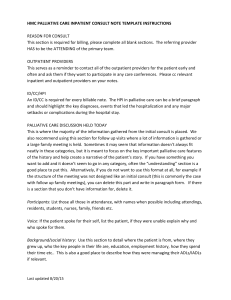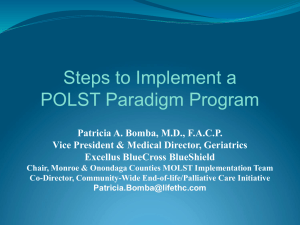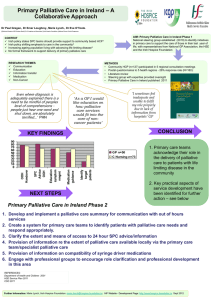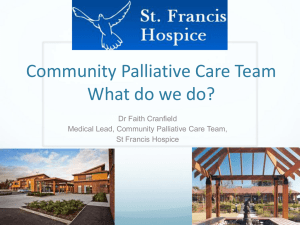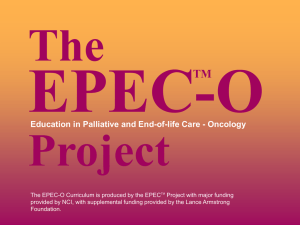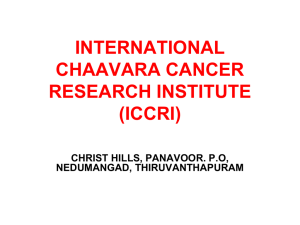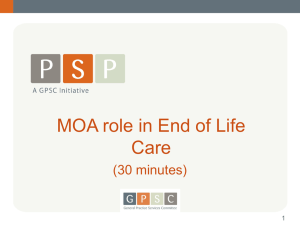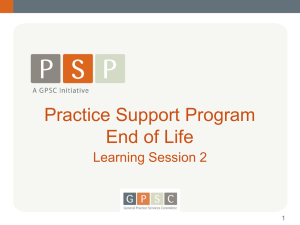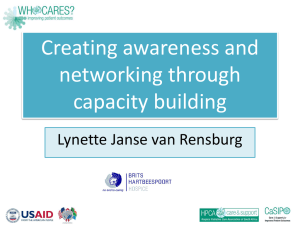Palliative Care & Hospice - New York State Academy of Family
advertisement
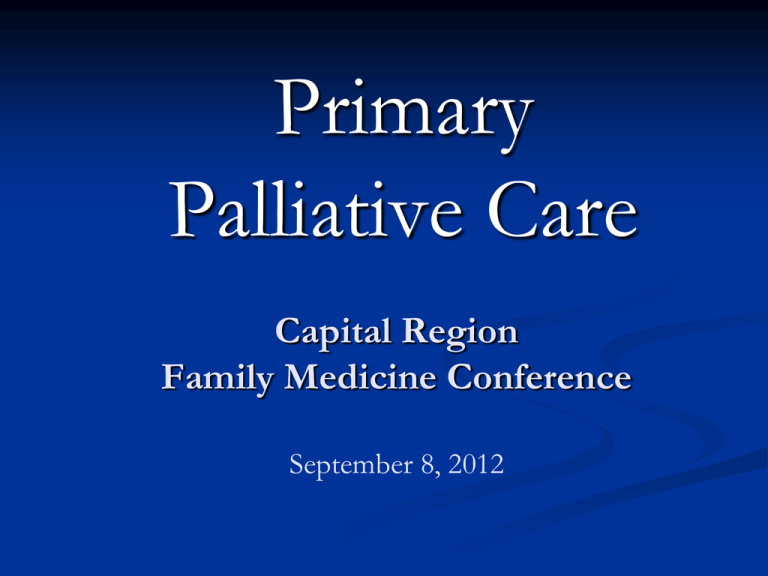
Primary Palliative Care Capital Region Family Medicine Conference September 8, 2012 Objectives Describe shared skills of palliative care and primary care Identify useful communication techniques Medical Orders for Life Sustaining Treatment Diagnosis ------- Chronic Illness ---- Death Curative Efforts --------------------- Life Prolonging Measures ---------------------------------------- Palliative Care (Hospice) ---------------------------------------------------------------- Russell Portenoy, MD All of hospice is palliative care, but not all of palliative care is hospice Palliative Care Hospice “ The American College of Chest Physicians strongly supports the position that palliative and end-of-life care of the patient with an acute devastating or chronically progressive pulmonary or cardiac disease and his/her family should be an integral part of cardiopulmonary medicine.” Chest 2005 / VJ Vanston AAHPM 2010 40% report acute and chronic pain at levels similar to patients with cancer 23% report neuropathy, fatigue, depression, sleep disturbance “Diabetes care management should include not only good cardiometabolic control, but also symptom palliation across the disease course.” J General Internal Medicine Aug 2012 Newly dx’d ambulatory metastatic non-small cell lung cancer MGH Standard treatment vs. Standard treatment + palliative care Intervention group better QOL scores lower rates of depression 2.7 month survival benefit less chemotherapy Temel, et al NEJM Aug. 2010 Hospital based interdisciplinary teams – MD, NP, RN, SW, PC 89% of hospitals > 300 beds Palliative Care Skill Set Advance care planning Symptom Managment Establishing patient-centered / realistic goals of care Appropriate level (setting) of care Coordination of care Palliative Care Information Act 2/2011 Public Health Law section 2997-c requires the "attending health care practitioner" to offer to provide patients with a terminal illness with information and counseling regarding palliative care and end-of-life options appropriate to the patient, including: Prognosis; Range of options appropriate to the patient; Risks and benefits of various options; Patient's "legal rights to comprehensive pain and symptom management at the end of life." http://www.health.ny.gov Case Study 88 year old female Dementia, HBP, osteoporosis, hyperlipidemia, anemia, arthritis, impaired nutrition Assisted living facility June 2008 sent to ER for increased confusion - uti MRI/Neuro consult/ EEG/ carotid US Discharge meds: Iron, Nexium, Norvasc, Fosamax, Zocor, Folic Acid, Levaquin, Aricept, Aspirin Sept 2008 Sent to ER for lethargy Hematemesis and aspiration pneumonia GI consult EGD – severe esophagitis Pulmonary consult CT, thoracentesis IV antibiotics Discharge meds: Zocor, Aricept, Nexium, Cardiezem, Norvasc, Fosamax November 2008 Sent to ER for lethargy and anemia Contracted, minimal verbalization 4 stage III-IV pressures sores Urinary tract infection Family contacted HC Proxy and Living Will Comfort and Returning to Community Stopped Fosamax, Zocor Started RTC pain medicine, Wound care Allowed to eat as tolerated NonHospital DNR Hospice referral Quality in healthcare is defined as: Patient-centered Timely Beneficial Equitable Safe Efficient National Quality Forum www.qualityforum.org Institute for Healthcare Improvement www.ihi.org Medicine used to be simple, inexpensive, and relatively safe. Now its complex, effective, and potentially dangerous. Sir Cyril Chantler Hospitalization-Associated Disability Covinsky, Pierluissi, Johnston JAMA October 2011 “occurs in approximately one-third of patients older than 70 years of age and may be triggered even when the illness that necessitated the hospitalization is successfully treated.” Patient vulnerability and capacity to recover Age Poor mobility Cognitive function ADLs Social functioning Depression Geriatric syndromes (falls, incontinence) Severity of Illness Hospitalization Factors Environment Restricted mobility Enforced dependence Undernutrition Little encouragement of independence Covinsky, Pierluissi, Johnston Polypharmacy JAMA October 2011 Don’t underestimate your role Let the patient set the agenda Encourage discussion and completion of advance directives “Hope for the best but be prepared for the worst” Goals of Care Shift –Time for Discussions 43% 1 year mortality rate after hospitalization for AECOPD with pCO2 > 50 17-20% 1 year mortality from dx of CHF 25-30% 1 year mortality rate following Hip Fracture 2 month median survival when majority of day in bed or chair in patients with metastatic cancer What Do Patients with Serious Illness Want? Pain and symptom control Avoid inappropriate prolongation of the dying process Achieve a sense of control Relieve burdens on family Strengthen relationships with loved ones Singer et al. JAMA 1999;281(2):163-168. D Meier , CAPC 2009 Factors that Influence Hope Decrease Hope Feeling diminished as a person Abandonment and isolation Lack of direction Uncontrolled pain and discomfort Increase Hope Feeling valued as a person (reminiscence) Meaningful relationships (humor) Realistic goals Pain and symptom relief Oxford Textbook of Palliative Medicine http://www.oncotalk.info/ Robert Arnold, MD Director of the Institute of Doctor-Patient Communication at the University of Pittsburgh http://www.oncotalk.info James Tulsky, MD Director of the Center for Palliative Care at Duke University http://www.oncotalk.info/ Communication Techniques Sit Down Maintain eye contact “Active” Listening Pause Manage emotion Normalize feelings Reflect patient’s own words Factual Questions / Expression of Emotion Fire a “warning shot” Hospitalizations During Last 6 months of Life Medicare Patients 2007 Percent of Decedents Admitted to ICU/CCU During the Hospitalization in Which Death Occurred 2007 Medicare Patients 20% of all deaths in the US occur in the ICU or shortly after an ICU stay Angus CritCareMed 2004 The 4 Stages of Man Advance Care Directives For All Adults Health Care Proxy Form Living Will Organ Donation (optional) For Those Who Are Chronically Ill or Near the End of Their Lives Nonhospital Do Not Resuscitate (DNR) Order Medical Orders for Life Sustaining Treatment (MOLST) form POLST/MOLST Communication Documentation System Responsiveness Core Elements of MOLST Actionable medical orders Advanced, chronic progressive illness Limit or request all medically treatments Direction about resuscitation status Other types of intervention – future hospitalizations, tube feedings POLST Research findings Oregon Effectively communicates requests for DNR, comfort measures Frail elderly make reasonable choices Not all or none (JAGS, J Gerontol Nurs 2000-2004) Oregon, W Virginia, Wisconsin Less likely to receive unwanted hospitalization and medical interventions (Hickman, JAGS July 2010) POLST 2006 Paradigm of communication, documentation, and system responsiveness Paradigm of communication, documentation, and system responsiveness POLST Paradigm Program 2006 POLST.org POLST 2012 http://www.ohsu.edu/polst/programs/state+programs.htm accessed 4/2012 Slide courtesy of P Bomba, MD April 2012 State of N ew Y ork D epartm ent of H ealth N onhospital O rder N ot to Resuscitate (D N R O rder) Person's N am e:___________________________________ D ate of Birth: _____/_____/_____ D o not resuscitate the person nam ed above. Physician's Signature ____________________ Print N am e _________________________ License N um ber ____________________ D ate _____/_____/_____ It is the responsibility of the physician to determ ine, at least every 90 days, w hether this order continues to be appropriate, and to indicate this by a note in the person's m edical chart. The issuance of a new form is N O T required, and under the law this order should be considered valid unless it is know n that it has been revoked. This order rem ains valid and m ust be follow ed, even if it has not been review ed w ithin the 90 day period. D O H -3474 (2/92) Accepted in outpt settings but… Does NOT include DNI Does not cover additional Rx’s 1 in 20 children will experience the death of a parent by the time they graduate from high school. Free Bereavement Resources Does NOT have to be a Hospice patient Wave Riders K -3rd grade 4th -8th grade Teens At schools during the day; referrals thru school social worker At Local Hospice office Kids Parents/guardians are in their own group ..how to help their children and to support themselves in their grief. 1. 2. 3. Decrease isolation Normalize grief Provide a framework for remembrance and meaning-making Resources compassionandsupport.org MOLST, advance directives, patient/family friendly eperc.mcw.edu/EPERC/FastFactsandConcepts pain and symptom management, ethics, communication skills

